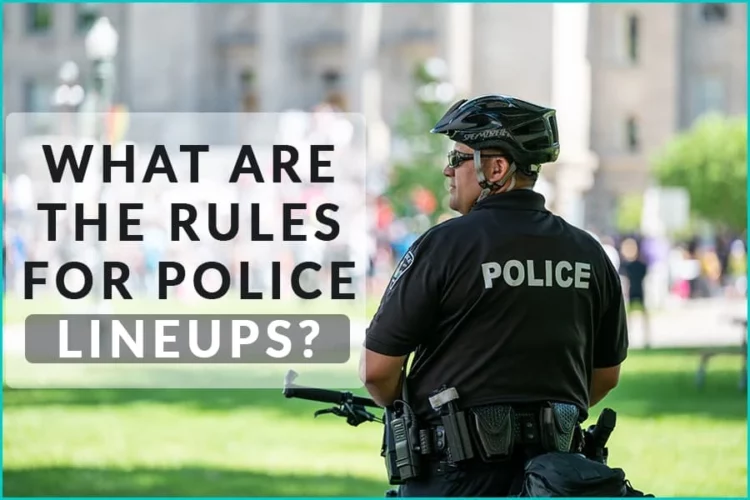Most of us have witnessed how police lineups work. It could be in TV series, movies, or physically. We may also have been involved in a lineup, either as a witness, filler, counsel or accused person.
Police lineups help investigators in several ways. The court might admit an eyewitness’ testimony.
In live lineups, the main suspect may also be in police custody. But the witness’ testimony can help confirm the police’s claim that the said suspect is the right person.
However, lineups have rules. And when the police break the rules, evidence from the lineup might not be accepted in court. Now, let’s take a close look at the rules for police lineups.
What Are The Rules For Police Lineups?
The rules entail that the lineups must be free and fair. Lineups must be unbiased and conducted in a certain way for the court to admit them.
Now, what are the other rules on lineups? Firstly, the police mustn’t assist the eyewitness in identifying the suspect. They mustn’t pressure the witness into choosing whoever they want.
Secondly, the police must provide fillers that somehow resemble the main suspect. They have to provide four or five fillers too.
Another rule is that the defendant’s counsel must be present during the lineup. Why? Their presence is to ensure the process is free and free. The defendant’s counsel won’t have any reason to fault the process when present at the lineup.
However, keep in mind that a defendant’s counsel is not important in DNA or blood sample tests. All these can be conducted in the counsel’s absence and results presented in court as evidence.
The presence or absence of the defendant’s counsel when the DNA or blood sample tests took place won’t change the result.
What Police Lineups Are
Ask any police detective what the hardest part of their job is. You’ll discover that identifying a suspect is the toughest. Firstly, the detective wasn’t there when the crime was committed. Secondly, detectives don’t have supernatural powers to determine who the culprit is.
On the other hand, suspects won’t wait for the police to arrive after committing crimes. They must have fled the scene and probably destroyed all the evidence before the police arrived.
Like in the movies, the police can use a lineup to confirm their suspicion of a suspect. The eyewitness testimony in the lineup can serve as evidence admissible in court.
In movies where lineups are conducted, you’ll find a stern cop asking the witness, “Mrs. Amelia, can you identify the person who committed the crime?” A shaky or confident Mrs. Amelia may point to the rugged-looking bearded guy and say, “He’s the one, sir!” And that’s it.
Now, what does a police lineup mean?
Lineup refers to a formalized procedure wherein a suspect is placed among a group of four or five people, and an eyewitness or the victim is asked to identify who the culprit is.
The police lineup is crucial in the United States criminal justice system. It helps provide evidence to convict a suspect for an alleged crime.
Types Of Police Lineups
Different types of police lineups exist. These include live lineup, photo lineup, and video lineup. Now let’s discuss each of the lineup forms.
#1: The live lineups:
Here, the main suspect and fillers (individuals that look quite like the suspect) are present in a live lineup. The fillers can be four or six individuals.
So, a live lineup might include the main suspect and five fillers. It can also be a blind and non-blind lineup.
What’s a blind lineup? It implies a lineup where the lineup administrator doesn’t know who the actual suspect is.
The non-blind lineup is the direct opposite. It refers to a lineup where the administrator knows who the main suspect is.
Knowing the suspect doesn’t mean the investigator or lineup administrator should influence the witness’ decision. A lineup won’t be admissible in court if the police influence the witness’ decision.
The police have to provide the suspect and other non-suspects. Then the eyewitnesses have to check the suspects presented to identify the culprit independently.
However, remember that the defendant’s counsel must be present at the lineup. The main suspect and individuals used as fillers should also share some resemblance.
#2: Photo lineups:
A Six-pack lineup is another name for a photo lineup. Why? The lineup usually includes the main suspect and five fillers.
Photo lineups can be simultaneous or sequential. In other words, the eyewitness may be asked to view the image of the suspects sequentially or simultaneously.
Viewing photos in sequence implies going through them one after the other. The eyewitness has to finish looking at one image before being presented with the next one.
On the other hand, simultaneously viewing images involves going through all the images at once. Here, the eyewitness is presented with the images of all the suspects simultaneously.
A study comparing the effectiveness of how eyewitnesses view photos claims viewing images in sequence could be more accurate than simultaneously.
When allowed to view images simultaneously, a witness may likely misidentify the suspect. How? The eyewitness may choose a suspect that appears as the guilty person.
The police also conduct photo lineups under certain conditions, such as.
- When the police are yet to arrest the primary suspect and thus, can’t present anyone for a live lineup.
- The suspect had altered his appearance after committing the crime. Thus, the investigator wants the witness to look at a photograph before the crime.
#3: Video Lineups:
A video recording of the suspect is presented in a video lineup. The investigator allows the eyewitness to view the video and identify the culprit.
Are Police Lineups Accurate?
Lineups have helped the police solve difficult cases, including cases that have gone cold. But we cannot deny the fact that misidentification happens. And many innocent citizens are rotting away in jail because of misidentification by an eyewitness.
So, police lineups are not always accurate. Firstly, there’s a possibility that a detective eager to solve a case quickly might want to assist the eyewitness in picking a certain individual.
The fault can also be from the eyewitness. The truth is that crimes happen fast. Most people may also cover their faces when committing a crime. And there’s a possibility that the crime occurred in an environment with low light.
So, if the proposed eyewitnesses can’t see the suspect’s face properly, how can they identify the person? We should also not forget that eyewitnesses have little time to observe crimes. And where the suspect has a weapon, the witness’s focus might be on that weapon.
A person’s memory also fades with time. And that’s what happens to most witnesses. Most witnesses might indicate their willingness to identify suspects after a year or more. Thus, they might not remember the complete details of the suspect.
A study re-evaluating the accuracy of police lineups has indicated that tons of people are languishing in jail because they were misidentified by eyewitnesses. If not for DNA tests, many people would have remained in prison, serving punishments for crimes they didn’t commit.
Conclusion
What are the rules for police lineups? Firstly, the police mustn’t do anything to influence the witness’ decision. They must not help the witness identify the suspect.
The lineup must be conducted in the presence of the defendant’s counsel. Otherwise, the court might not admit the evidence.
The lineup administrator must also ensure the main suspect and four or five fillers are provided for the lineup. The fillers should resemble the suspects too.










